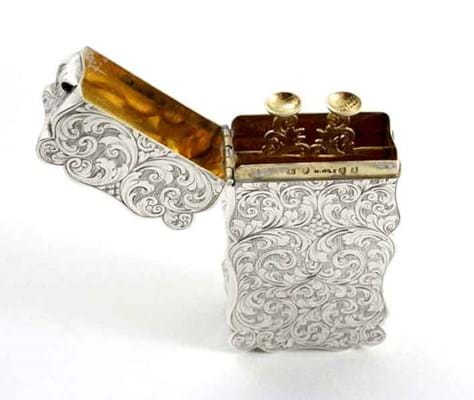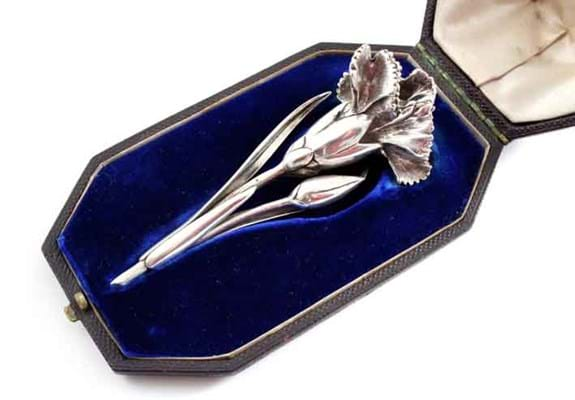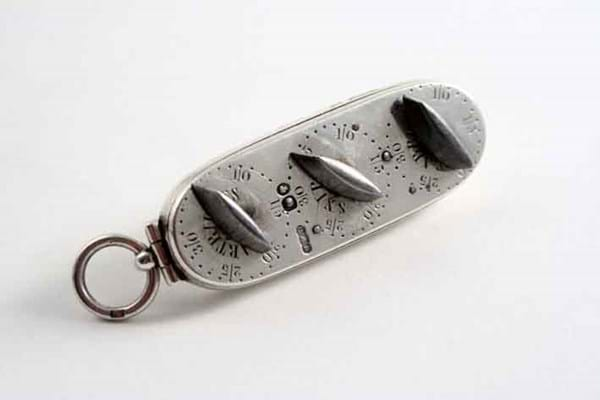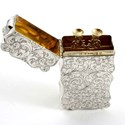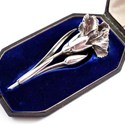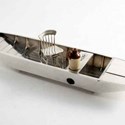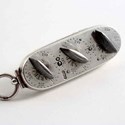His background in engineering and metalwork lent a sense of wonder to his first visit to the Burlington Arcade when choosing a suit in Savile Row in 1983. Window shopping at the store of Gerald Sattin soon led to a serious collecting habit that only 800 purchases, from a walnut-form vinaigrette to a propelling pencil fashioned as a spigot, could satisfy.
Always keen to share his enthusiasm, when entertaining at home he would remove a dozen pieces from the cabinet and leave them for the enjoyment of the invited and to encourage discussion. It was the source of considerable disappointment to him that recent guests had ignored them completely - and that was among the reasons his remarkable collection was offered at Lawrences of Crewkerne on October 11.
What made the collection unusual was Bramah's decision to cast his net wide across a number of different collecting disciplines. Amongst these 800 (principally) Victorian and Edwardian pieces, were micro collections of bookmarks, card cases, nutmeg graters, vinaigrettes, snuff boxes, whistles, scent bottles, vestas, stamp boxes, inkwells, pencils and pepperettes - not to mention the occasional item that defied classification.
However Bramah had quickly realised the need for some boundaries in a huge field: "Wherever possible he focused upon items of British origin," said Lawrences' specialist Alex Butcher. "He preferred good craftsmanship and design to mere ornamentation (for example he owned relatively few 'castle tops') and he realised that he had to limit his collection's physical size by concentrating upon small pieces to hold in the hand."
The final lot of the sale was the 2ft 4in (72cm) high Victorian brass-bound mahogany surgeon's cabinet with seven internal drawers (each with a lift-out 'grid' of compartments) in which all the collection were housed. It added £1550 (estimate £500-700) to a total that, with after-sales, crept over £300,000.
Around 75 per cent of the lots were sold on the day.
Rather than a case of too much of a good thing (the content appealed to a wide spectrum of collectors) this was an indication that estimates were on the whole sensible but occasionally just a little stiff. Bramah bought retail and he bought broadly. There were items here that even a smallwork veteran such as Alex Butcher had not catalogued before but there were many (particularly those acquired relatively early in Bramah's collecting odyssey) that were more common and, accordingly, price sensitive.
But, if the sale had its bald patches then its major components did not disappoint.
Vinaigrettes
A group of Victorian naturalistic vinaigrettes were eagerly competed, with the example by Jane Brownett (London 1885) in the form of a walnut with an unusual hinged grille resembling the nut itself selling at £3500 (estimate £2000-2500), and another in the form of a 4½in (11.5cm) long carnation flower and bud by E.H. Stockwell, London 1876, sold in its original case at £3800 (estimate £2500-3000).
Many of the pieces were by Sampson Mordan with whom there was a family connection (in his youth Sampson Mordan Snr (1790-1843), co-inventor of the first patented mechanical pencil in 1822, was an apprentice of Joseph Bramah). More than 20 different Mordan & Co propelling pencils offered here included rare novelties in the form of a grandfather clock with enamelled dial (£1150) and a champagne tap or spigot (£1450).
A strong £3800 (estimate £2000-2500) was bid for a 5in (12.5cm) Victorian novelty scent flask and vinaigrette in the form of a champagne bottle - a design registered by Mordan in 1869. For the vendor at least, it compares favourably with other examples sold at Woolley & Wallis of Salisbury in 2004 (£2300) or Wintertons of Lichfield in 2005 (£2400).
But some of the most ingenious and best made objects were by the less-prolific London 'toy' maker Henry William Dee.
These included a 3¼in (8.5cm) high sewing compendium and vinaigrette in the form of a hen's egg in an egg cup (London 1875) - the lacquered top opening to reveal a needlecase, pin holder, thread bobbin and thimble, the base with a hinged grille and cover - and a 2in (5cm) long pocket game counter with dials to record pheasants, woodcock, hares, partridges, snipe and rabbits (London 1868 retailed by Thornhill).
These sold at £2300 (estimate £2500-3000) and £4700 (estimate £2500-3000) respectively.
Also by H.W. Dee, (London 1875) was a 1¼in (3.2cm) diameter sphere opening in multiple compartments to reveal a vinaigrette, compass, photo frame and coin holder. They are rare but another, dated 1873, sold at Sworders of Stansted Mountfitchet in 2005 for £2100. This one took £1800 (estimate £1700-2000).
The highest priced piece in the sale was by Nathaniel Mills, a 4in (10cm) long table nutmeg grater with a split domed cover (one side for the nuts, another for the grater) struck for Birmingham 1848. Estimated at £4000-5000, it took £6600.
Bramah's example of Matthew Linwood's well-known 1805 Nelson vinaigrette with a Victory grille and an engraved portrait with the legend England Expects Every Man Will Do His Duty, shown above, was a particularly good one.
Some of these were initially made with plain covers - the engraving added -later to boost their commercial appeal - however the hammer price of £4700 (estimate £3000-4000) demonstrated the confidence that this was of the period.
With such a representative selection of items, this is one catalogue well worth keeping.

